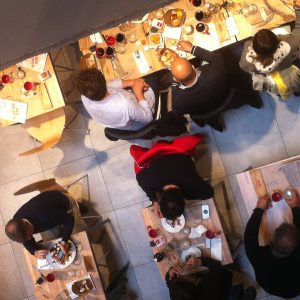You’re moving to Italy, they cried. Think of all the wonderful food you’ll eat every day! Your kids will learn to eat well, you can shop for fresh, amazing, natural and colourful food at the market everyday and absorb ancient secret recipes for the healthiest food on the planet! Washed down by good wine which will be cheaper than water!
It sounds good doesn’t it?
And yes, the whole food side of things is wonderful now we live in Italy and it’s fascinating to observe how it is completely integrated into daily life. In fact, I’m holding myself back from gushing too much – my Norwegian readers will understand just how amazing it is after years in the barren aisles of Rema, Coop and Kiwi, forced to buy overpriced, low-choice foodstuffs. Eating out with our kids in Oslo was something we could rarely afford to do and we often travelled home from a trip abroad with a bag full of basic groceries (cheese, ham, even soap) that was cheaper abroad; even from Denmark or Germany.
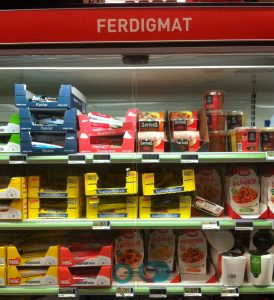
But like any element of life in a new country, you begin to see more complexity. This is also true when you start eating like a local.
When we first arrived, we behaved like tourists (well, Norwegian tourists) who relish the thought of living amidst all this good stuff.
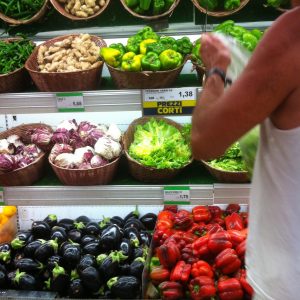
Here we were in Tuscany at the end of summer and markets and restaurants overflowing with tomatoes, aubergines, greens, beans, watermelon, and oranges. Into autumn we got to taste the fresh red wine (vino novo), the type that’s not even corked and goes fizz in your mouth. We ate well and started to explore the local flavours, encouraging our kids to try new foods. On their first day of pre-school camp they had clearly clued into the behaviour of their new peers. What did they give you for lunch, we asked them. Oh just rabbit lasagne.
We soon realized how food is part of the conversation. Every conversation, in fact. In other places the default topic is the weather or real estate. In Italy it’s food, among strangers, friends and especially family. It makes sense, there’s so much to say, so you can see how it’s treated with great respect and interest.
A Scottish friend who’s lived here many years told me how she first found it so dull, all this chat at the office lunch table about olive varieties or fillings for tortellini or the new pizzeria up the road, but after a while she got into it and finds many reasons to talk about it. And we’re heading that way too.
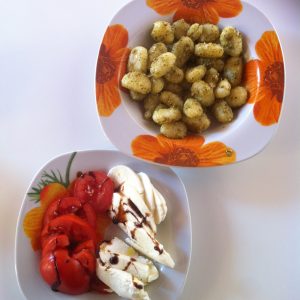
Italians love to talk and that’s what cellphones were designed for. (Smart phones are still mostly used as conversational devices here, often shoved up the side of your moped helmet just before you put it on and buzz off down the road). On the bus, walking down the street, if you tune in to someone talking on their phone, you’ll almost certainly hear it’s about food: “can you pick up some of that and we’ll serve it with the rice, enough for 8” or “how did you make that filling, it was delicious” or just “where did you book for lunch on Sunday?”
Any visitor to Italy has enjoyed the typical three-course meal imbibed over a lazy hour or two, often with friends: pasta or rice followed by fish or meat and dessert and coffee, with wine and water. It’s a wonderful way to eat when you’re on holiday, if you’re keen to try lots of new flavours in a new region. You can find strongly-held traditions when it comes to what should be eaten when, with what sauce, and in what season. When you’re living and cooking here, you find your own way to cook up all those ingredients from the market, start working through the shelves of pasta: spaghetti number 3, spaghetti number 1 or fresh pici (my new favourite). And I even tried out making pasta – so far just once.
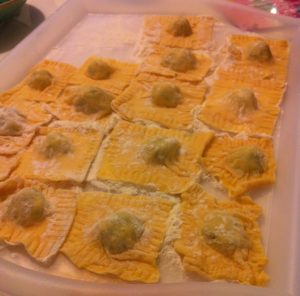
So we kept eating, but then I was posting fewer posts online of amazing pasta dishes, gelato or just the simple lunches I rustled up at home. We do sometimes make the trip to shop at the market – always an enjoyable experience – but it’s easier to get to a supermarket every day. Just as millions of Italians do. And d’you know what? Not every Italian is an expert cook – cooking classes are popular everywhere and people do buy frozen pizza!
Then after a while, you realise you’re not crazy about the unsalted butter or unsalted bread and you start to crave some hearty Norwegian wholegrain spelt. Or, much as you appreciate the fantastic artichokes appearing week after week, you never really master a way to cook them. You don’t really fancy eating tripe for lunch, famous as it is meant to be.
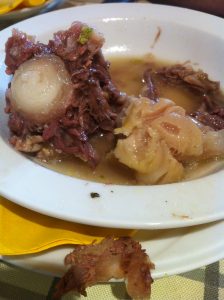
And then you finally admit to yourself, that really you wouldn’t mind a curry. If you manage to find the ingredients at the supermarket, keeping your head down while you browse the corner section with international foods. Or how about some rhubarb! I can’t find that in Tuscany.
At home with the kids I often cook a normal (i.e. Irish/Norwegian) dinner of meat and two veg and recently it was a bizarre treat to cook up an old-fashioned macaroni and cheese for the kids – I barely remembered how to do it and to me the taste was an instant return to New York, and a little place off Union Square that served up single tureens of steaming, cheesy mac & cheese.
Another issue is food quality and knowing what you’re buying. Even where we live, out towards the countryside, it’s not easy to find organic meat or the best quality eggs. I’ve only begun to read about Italy’s huge industrial food industries and realise the farmers markets we have found really need more customers, like for this delicious local red wine. The woman who produced it had to remind us to pour out the top oil coating before drinking the wine. Olive oil, the original wine preservative.

I’m still excited by most of my shopping experiences – like this handy box of basil I found in the frozen section. And I’m still trying to figure out the best ways to use an ingredients like fabulous sage (salvia) which grows profusely in our garden and yet the Coop sells a tiny packet in plastic for €1.26. I know, I should be ashamed of myself! At least I’m getting to learn more how to cook through meeting great people.
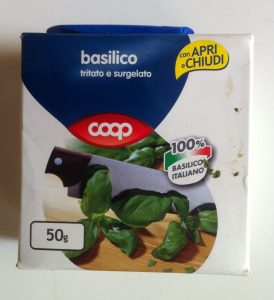
The kids – are they learning to eat well? It’s hard to tell. They have developed a new relationship to food through eating new things and being served three-course hot lunches at school. But they’re also young and – here’s a revelation – Italian kids are picky too, and they don’t always get the best choices in food. Yes, even in Italy! More on that in another blog post.
Eating here is a wonderful experience, and all that you could imagine. It’s hard to admit it’s not perfect, many friends (and not just serious foodies) would give their eye teeth to live where we do. Believe me, we are grateful for it and the opportunity to learn how it can be such an integral part of the culture we’re living in – a bigger part than it has been for me before.
